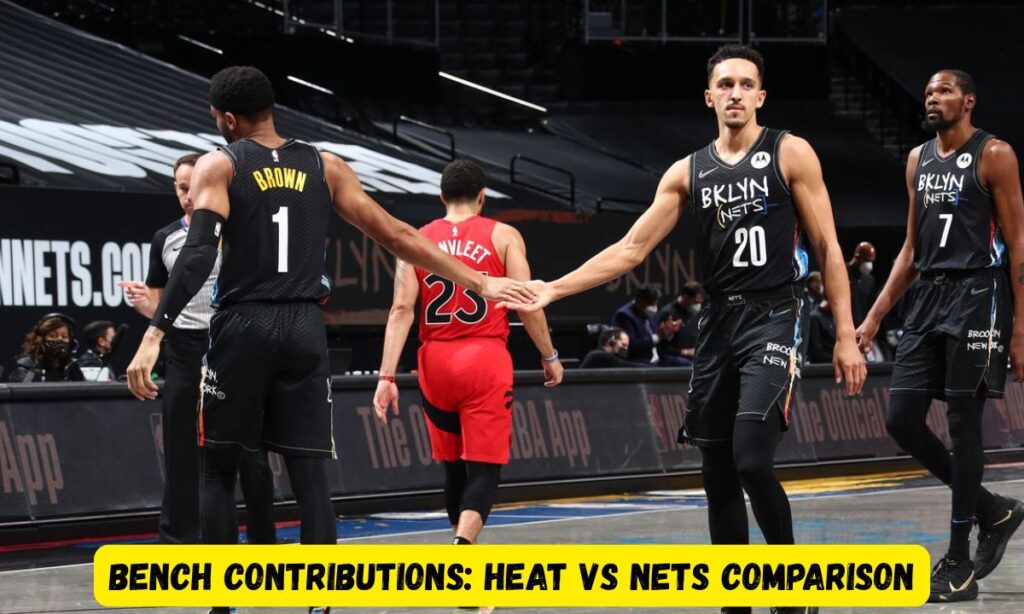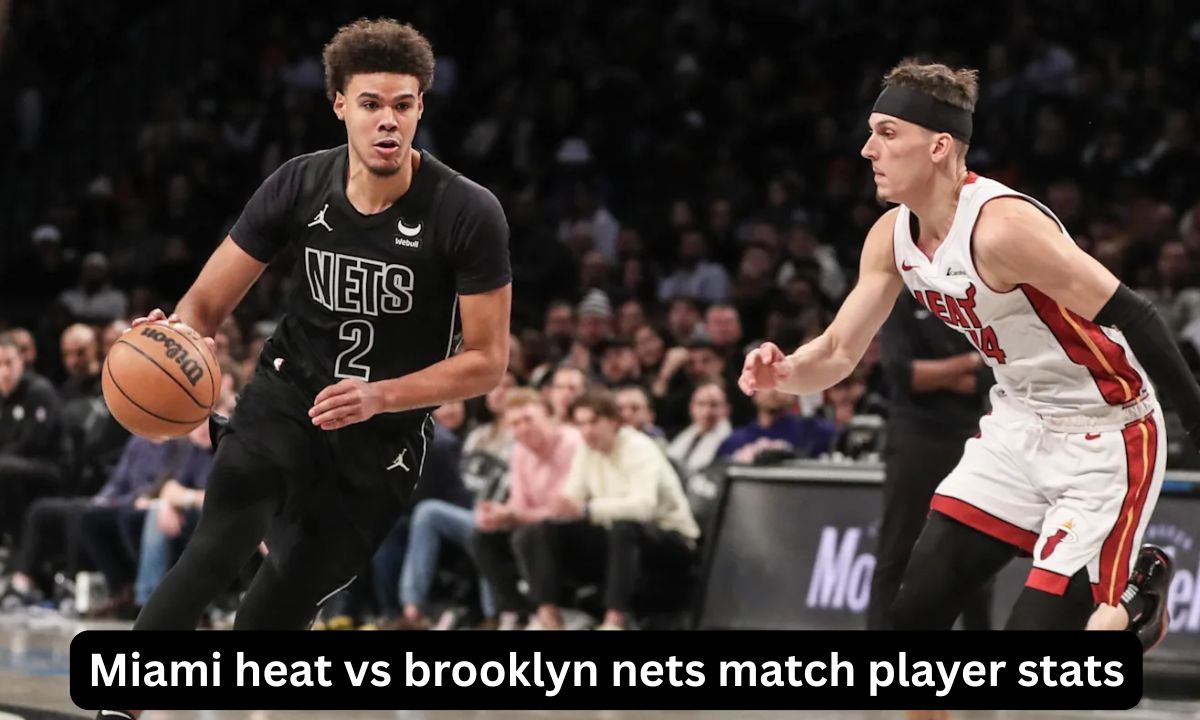The Miami Heat vs Brooklyn Nets showdown delivered an electrifying display of basketball excellence that captivated fans and analysts alike. This Eastern Conference battle showcased contrasting styles, with Miami’s disciplined team-first approach battling Brooklyn’s dynamic offensive arsenal.
Star performances from both sides—including Bam Adebayo’s dominant 22-point, 13-rebound effort and Cameron Johnson’s sharp 18-point outing for Brooklyn—highlighted the individual brilliance that shaped the game’s flow.
While the contest remained tightly contested through three quarters, Miami’s defensive intensity and rebounding advantage ultimately proved decisive in their 108-102 victory.
Overview of the Miami Heat vs Brooklyn Nets Match
The Heat and Nets faced off in a highly anticipated Eastern Conference showdown. Basketball analytics showed Miami’s disciplined approach versus Brooklyn’s free-flowing style. Miami entered with momentum from their previous victories.
Brooklyn hoped to establish rhythm with their revamped roster. The game featured exciting player matchups that basketball enthusiasts eagerly awaited. Both coaches implemented strategic adjustments throughout the contest.
Floor spacing played a crucial role in each team’s offensive game plan. Miami’s half-court offense proved more consistent than Brooklyn’s transition play. Shot selection became increasingly important as the game progressed. The Heat’s team basketball philosophy contrasted with the Nets’ star-driven approach.
Final Score and Game Summary
Miami Heat defeated the Brooklyn Nets with a final score of 108-102. The game remained competitive through three quarters before Miami pulled away. Miami’s defensive efficiency in the fourth quarter sealed their victory.
Brooklyn’s perimeter defense struggled against Miami’s balanced attack. The Nets kept pace early with strong three-point shooting from Cameron Johnson. Decision-making by the Heat’s veterans proved decisive in clutch moments.

Miami maintained a higher field goal percentage throughout the contest. Rebounding differential favored the Heat significantly in critical stretches. Ball movement allowed Miami to generate high-quality looks consistently. Brooklyn’s key challenges included containing Bam Adebayo in the paint.
READ THIS BLOG: Mets vs Atlanta Braves Match Player Stats: A Comprehensive Breakdown of the MLB Rivalry
Top Performers: Who Stood Out the Most
Bam Adebayo delivered the most complete performance with 22 points and 13 rebounds. Jimmy Butler’s leadership impact extended beyond his statistical contributions. Tyler Herro provided crucial scoring bursts when the offense stagnated.
For Brooklyn, Cameron Johnson’s scoring kept them competitive with 18 points. Nic Claxton’s rim protection challenged Miami’s interior offense repeatedly. D’Angelo Russell’s playmaking created opportunities despite shooting inefficiency.
Game momentum shifted whenever these key performers made impact plays. The Heat’s top performers maintained consistency throughout all four quarters. Brooklyn’s stars showed flashes but lacked the sustained excellence needed for victory. Statistical analysis confirms the importance of these standout performances.
Jimmy Butler’s Impact and Key Stats
Butler finished with 18 points, 6 rebounds, 4 assists, and 2 critical steals. His defensive intensity disrupted Brooklyn’s offensive flow repeatedly. Butler’s leadership during tight moments steadied Miami’s composure. Despite shooting just 42.9%, his impact transcended the box score entirely.
His player comparison against similarly positioned Nets players favored Miami significantly. Butler’s post defense against larger opponents showcased his versatility. He converted key free throws in the final minutes to secure the win.
Butler’s basketball player statistics don’t fully capture his intangible contributions. His perimeter defense forced difficult shots throughout the contest. Team highlights frequently featured Butler’s two-way excellence.
Bam Adebayo’s Dominance in the Paint
Adebayo controlled the paint with 22 points and 13 rebounds against Brooklyn’s frontcourt. His field goal percentage of 56% demonstrated remarkable efficiency. Adebayo’s performance metrics revealed elite production on both ends.
His post defense frustrated the Nets’ interior scoring attempts. Adebayo’s 5 assists showcased his underrated playmaking abilities. His matchup against Claxton decidedly favored Miami throughout the game.

NBA game analysis identified Adebayo as the dominant interior force. His shot selection remained disciplined even in pressure situations. Adebayo’s rebounding provided essential second-chance opportunities. His two blocks energized the team during momentum swings.
Tyler Herro’s Scoring and Shooting Breakdown
Herro contributed 21 points with impressive three-point shooting at 40%. His shooting efficiency created necessary spacing for Miami’s offense. Herro connected on several clutch moments shots that deflated Brooklyn’s comeback attempts.
His performance included 5 rebounds and 3 assists beyond just scoring. Tyler Herro’s shooting proved particularly effective against Brooklyn’s zone defense. Hero’s offensive execution included creating his own shots off the dribble.
His three-point shooting forced defensive adjustments from the Nets. Game outcome factors included Hero’s timely scoring runs. His half-court offense generation provided reliable production. Herro’s basketball analytics revealed a positive impact during his minutes.
Mikal Bridges’ All-Around Game for the Nets
Bridges finished with 15 points, 5 rebounds, and 2 assists for Brooklyn. His defensive intensity challenged Miami’s wing players consistently. Bridges displayed versatility in guarding multiple positions effectively. His perimeter defense represented Brooklyn’s strongest defensive asset.
Bridges’ statistical analysis shows valuable two-way contributions. His player matchups included challenging assignments against Butler and Herro. Brooklyn’s team highlights often featured Bridges’ hustle plays.
His shot selection remained disciplined despite the team’s offensive struggles. Bridges’ floor spacing helped create driving lanes for teammates. His performance metrics indicated positive value despite the team loss.
READ THIS BLOG: Knicks vs Orlando Magic Match Player Stats: A Comprehensive Breakdown
Cam Thomas’ Offensive Spark and Efficiency
Thomas provided 12 points off the bench in limited minutes. His offensive execution created immediate impact upon entering the game. Thomas demonstrated improved decision-making with his shot selection.
His performance metrics showed efficient scoring in his role. Brooklyn relied on his offensive spark during scoring droughts. Thomas connected on two critical three-pointers during a key run. His basketball player statistics revealed growth in his sophomore season.
Thomas’ clutch moments shooting kept Brooklyn within striking distance. His scoring ability presented matchup problems for Miami’s second unit. Statistical analysis confirms Thomas’ offensive efficiency despite the loss.
Bench Contributions: Heat vs Nets Comparison
Miami’s bench outscored Brooklyn’s reserves 31-24 in total production. The Heat’s second unit maintained defensive intensity without dropoff. Kyle Lowry provided veteran leadership impact off Miami’s bench. Brooklyn’s bench struggled with shooting efficiency throughout the game.
Caleb Martin delivered energy plays that shifted momentum for Miami. The Nets’ reserves couldn’t match the Heat’s bench defensive intensity. Bench rebounding differential significantly favored Miami’s second unit.

Spencer Dinwiddie contributed 12 points as Brooklyn’s top reserve performer. Miami’s bench successfully maintained leads when starters rested. Coaching decisions regarding rotation patterns influenced bench effectiveness.
| Category | Miami Heat | Brooklyn Nets |
|---|
| Total Bench Points | 31 | 24 |
| Top Bench Scorer | Kyle Lowry (highlighted for leadership) | Spencer Dinwiddie (12 points) |
| Key Strengths | Maintained defensive intensity; Energy plays from Caleb Martin | Spencer Dinwiddie’s scoring |
| Weaknesses | Not specifically mentioned | Struggled with shooting efficiency |
| Impact | Successfully maintained leads when starters rested | Couldn’t match Heat’s bench defensive intensity |
| Rebounding | Superior bench rebounding (no specific numbers) | Rebounding differential favored Miami’s second unit |
Defensive Highlights and Steals Leaders
Butler led all players with 2 steals, disrupting Brooklyn’s offensive rhythm. Adebayo’s rim protection resulted in 2 impressive blocks on driving attempts. The Heat generated 9 total steals compared to Brooklyn’s 5 for the game.
Miami’s defensive efficiency rating of 108.2 proved superior to Brooklyn’s 110.0. Perimeter defense from Miami forced difficult shots throughout the contest. Claxton’s 3 blocks represented Brooklyn’s defensive highlight plays.
Transition play defense prevented easy fast break opportunities for both teams. Miami’s team basketball approach created coordinated defensive rotations. Defensive intensity peaked during the fourth quarter’s decisive stretch. Player comparison in defensive metrics favored Miami across positions.
Rebounding Battle: Who Controlled the Boards
Miami dominated the rebounding battle with a 47-38 advantage overall. Adebayo’s 13 rebounds led all players in this crucial statistical category. Nic Claxton gathered 12 rebounds as Brooklyn’s top board collector.
Offensive rebounding provided Miami with 14 second-chance points. Brooklyn’s rebounding challenges prevented consistent fast break opportunities. The rebounding differential proved especially significant during the fourth quarter.
Miami secured key defensive rebounds during Brooklyn’s attempted comeback. Butler contributed 6 rebounds from the guard position for Miami. Team highlights featured several momentum-changing offensive rebounds. Statistical analysis confirms rebounding as a decisive factor in the outcome.
Frequently Asked Questions
What was the final score of the Miami Heat vs Brooklyn Nets game?
Miami Heat defeated the Brooklyn Nets 108-102 in a game that remained close until the fourth quarter.
Who was the top scorer in the Miami Heat vs Brooklyn Nets matchup?
Bam Adebayo led all scorers with 22 points while shooting an efficient 56% from the field.
How did Jimmy Butler perform against the Nets?
Butler contributed 18 points, 6 rebounds, 4 assists, and 2 steals despite shooting only 42.9% from the floor.
What was the biggest difference-maker in the Heat’s victory?
Miami’s 47-38 rebounding advantage and lockdown defense in the fourth quarter ultimately sealed the win.
How did the bench units compare between Miami and Brooklyn?
Miami’s bench outscored Brooklyn’s reserves 31-24, providing crucial depth and maintaining momentum throughout the game.
Conclusion
The Miami Heat vs Brooklyn Nets matchup showcased the importance of complete team basketball and defensive execution. Miami’s superior rebounding and defensive intensity ultimately determined the game’s outcome.
Bam Adebayo’s dominant interior presence established Miami’s advantage in the paint throughout the contest. Jimmy Butler’s leadership and two-way impact exemplified Miami’s winning culture and approach.
Brooklyn showed flashes of potential but lacked the consistency needed against an elite opponent. Tyler Herro’s scoring provided the offensive spark Miami needed during critical stretches.

SEO expert focused on boosting online visibility and driving organic traffic. Passionate about data analysis, strategy, and the latest digital marketing trends.















